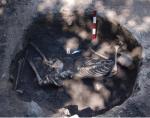Summary (English)
DISCODURATERAE (Ilian Boyanov – ilianboyanov@nbu.bg) The fortress had almost rectangular layout, 114/127 m by 85/94 m. The fortification wall was 1.40 m wide, constructed of roughly-cut stones bonded with mortar and combining opus incertum and opus vitatum. It was built at the end of the 3rd – beginning of the 4th century AD. Two layers with traces from fires were documented at the western corner fortification tower, dated accordingly to AD 400 – 425 (judging from a coin of Arcadius) and to AD 375 – 400 (judging from a coin of Valentinian II). A stratum containing coins of Constantine the Great was explored under the layers with traces from fires. The fortification gate has been explored during the 1960s. Its pillars were projected from both sides of the fortification wall and thus, they flanked the entryway of the gate from the outside and the inside. Barracks adjoining the fortification wall have been documented during the 1960s as well. In 2013 Building 9 was explored situated at 1 m in front of the southwestern fortification wall. Its foundations were 60 cm wide, built of roughly-cut stones bonded with clay, and its walls were constructed of sun-dried bricks. Fragmentary tegulae from the rood were discovered. The building dated at the end of the 3rd – 4th centuries AD. During the explorations of the 1960s, a grave was discovered close to the entrance of Building 3 and dated before the end of the 4th – beginning of the 5th century AD. During the excavations in 2011 – 2013 five graves were discovered inside the fortification. One burial was performed inside a midden pit and the body was thrown inside with folded arms and legs. A coin of Constantine the Great minted in Antioch in AD 330 – 335 and a bone clasp were found. The person was probably killed and the burial could be interpreted as a criminal case. The other four burials were Christian and dated to the 13th – 14th centuries.
- Ilian Boyanov - Department of Archaeology, New Bulgarian University
Director
Team
Research Body
- New Bulgarian University






![Download [PDF]](/excavation/skins/fasti/images/results/download_sml.png)

